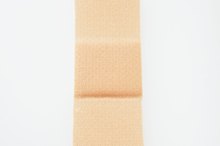How to Tell Whether a Staph Infection Is Healing
It isn't uncommon for each of us to have some sort of "staph" on our body at one time or another. More often than not, the Staphylococcus aureus bacteria will not pose much of an issue. The real problem comes into play when the staph gets into a break in our skin, which causes an infection. Normally, bacteria can be easily treated with standard antibiotics, but staph has actually become quite resistant to many of the medications used to treat and "heal" such an infection, making it even more important to take the necessary precautions to ensure you aren't infected with the bacteria. This doesn't mean that staph can't be treated; it just takes stronger medications to remedy the condition. Leaving a staph infection untreated can allow the bacteria to move deeper into your tissue and cause a serious medical condition that could even result in death.
If you are experiencing serious medical symptoms, seek emergency treatment immediately.
Consult a medical professional. This is truly the safest method to tell whether or not a staph infection is healing. Since you'll inevitably go through some course of treatment for staph infection, you should speak to a medical professional to ensure that the medication is effectively treating and properly healing the condition.
Ways to Tell You're Running a Fever
Learn More
Have a tissue sample taken. This sample will allow a physician to detect the status of the staph.
Offer a nasal secretion. While this may not seem like the most pleasant method of distinguishing the condition of your infection, a nasal secretion, much like a tissue sample, is a very valuable technique for checking the progress of your healing and your body's response to the medication.
Is It Better to Use a Ring Instead of a Stud for Lip Piercings While Healing?
Learn More
Keep an eye on the infection itself. When staph is localized to the skin, it will develop a fairly red area on a small surface of your body that may become inflamed, blister and even expand into a sore or ulceration. Keeping an eye on this area can give you a good indication whether your condition is healing properly. To tell whether your infection is healing, look for a reduction in swelling or inflammation, a scabbing of the blister or sore and a lessening (or fading) in the discoloration to the affected area of skin.
Feel the area of infection. Since many staph infections will not only cause the skin to become inflamed and red, but also quite warm and tender to the touch, you can lightly feel the affected area and compare it to unaffected areas. Once it's healed, the area should no longer feel warmer than the rest of your body or painful to the touch.
Assess the way you feel. If staph has infected you through the food you've eaten, you should monitor the healing process by checking that the nausea, abdominal cramping, diarrhea and vomiting are lessening or have passed.
Measure your temperature. Sometimes a person suffering from a staph infection will exhibit a moderate fever. By periodically taking your own temperature, you can gauge whether you're on the mend. However, you shouldn't simply stop taking your medication once this fever lessens or breaks. It is important to see treatment through to the end and consult with your doctor.
Tips
To help prevent staph infection, you should start washing your hands regularly and keep any breaks, sores or wounds in your skin clean and covered.
Make sure that personal items such as towels or razors or even athletic gear are used only by you.
Related Articles
References
- King JM, Kulhankova K, Stach CS, Vu BG, Salgado-pabón W. Phenotypes and Virulence among Staphylococcus aureus. USA100, USA200, USA300, USA400, and USA600 Clonal Lineages. mSphere. 2016;1(3). doi:10.1128/CMR.00134-14
- Cleveland Clinic. (September 2019). Staph Infection (Staphylococcus Infection)
- Tong SY, Davis JS, Eichenberger E, Holland TL, Fowler VG Jr. Staphylococcus aureus infections: epidemiology, pathophysiology, clinical manifestations, and management. Clin Microbiol Rev. 2015 Jul;28(3):603-61. doi:10.1128/CMR.00134-14
- Sukumaran V, Senanayake S. Bacterial skin and soft tissue infections. Aust Prescr. 2016;39(5):159-163. doi:10.18773/austprescr.2016.058
- Bush L. (Modified June 2019). Merck Manual Consumer Version. Staphylococcus aureus Infections. (Staph Infections)
- De oliveira TH, Amorin AT, Rezende IS, et al. Sepsis induced by Staphylococcus aureus: participation of biomarkers in a murine model. Med Sci Monit. 2015;21:345-55. doi:10.12659/MSM.892528
- Harris A (Updated January 2019). Patient education: Methicillin-resistant Staphylococcus aureus (MRSA) (Beyond the Basics). Lowy FD, ed. UpToDate. Waltham, MA: UpToDate.
- Centers for Disease Control and Prevention. Invasive Methicillin-Resistant Staphylococcus aureus Infections Among Persons Who Inject Drugs. Six Sites, 2005–2016.
- Hassanzadeh P, Hassanzadeh Y, Mardaneh J, Rezai E, Motamedifar M. Isolation of Methicillin-Resistant Staphylococcus aureus (MRSA) from HIV Patients Referring to HIV Referral Center, Shiraz, Iran, 2011-2012. Iran J Med Sci. 2015;40(6):526-30.
- Chu C, Wong MY, Tseng YH, et al. Vascular access infection by Staphylococcus aureus from removed dialysis accesses. Microbiologyopen. 2019;8(8):e00800. doi:10.1002/mbo3.800
- Tong SY, Davis JS, Eichenberger E, Holland TL, Fowler VG Jr. Staphylococcus aureus infections: epidemiology, pathophysiology, clinical manifestations, and management. Clin Microbiol Rev. 2015 Jul;28(3):603-61. doi:10.1128/CMR.00134-14
- Romero-gómez MP, Cendejas-bueno E, García rodriguez J, Mingorance J. Impact of rapid diagnosis of Staphylococcus aureus bacteremia from positive blood cultures on patient management. Eur J Clin Microbiol Infect Dis. 2017;36(12):2469-2473. doi:10.1007/s10096-017-3086-5
- Missiakas DM, Schneewind O. Growth and laboratory maintenance of Staphylococcus aureus. Curr Protoc Microbiol. 2013;Chapter 9:Unit 9C.1. doi: 10.1002/9780471729259.mc09c01s28
- Kobayashi SD, Malachowa N, Deleo FR. Pathogenesis of Staphylococcus aureus abscesses. Am J Pathol. 2015;185(6):1518-27. doi:10.1016/j.ajpath.2014.11.030
- Centers for Disease Control and Prevention. (2019). Deadly Staph Infections Still Threaten the U.S.
- Centers for Disease Control and Prevention. (2011). Staphylococcus aureus in Healthcare Settings.
Tips
- To help prevent staph infection, you should start washing your hands regularly and keep any breaks, sores or wounds in your skin clean and covered. Make sure that personal items such as towels or razors or even athletic gear are used only by you.
Writer Bio
Based in Minneapolis, Minn., Dana Severson has been writing marketing materials for small-to-mid-sized businesses since 2005. Prior to this, Severson worked as a manager of business development for a marketing company, developing targeted marketing campaigns for Big G, Betty Crocker and Pillsbury, among others.









